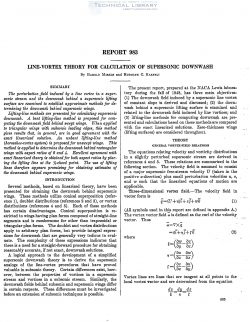naca-report-983

- Version
- 165 Downloads
- 1.38 MB File Size
- 1 File Count
- September 1, 2016 Create Date
- September 1, 2016 Last Updated
National Advisory Committee for Aeronautics, Report - Line Vortex Theory for Calculation of Supersonic Downwash

The perturbation field induced by a line cortex in a super-
sonic stream and the downwash behind a supersonic lifting
surface are examined to establish approximate methods for de—
termining the downwash behind supersonic wings.
Lifting-line methods are presented for calculating supersonic
downwash. A bent lifting-line method is proposed for com—
puting the downwash field behind swept wings. When applied
to triangular wings with subsonic leading edges, this method
gires results that, in general, are in good agreement with the
exact linearized solution. An unhent lifting—line method
(horseshoe-sorter system) is proposed for unswept wings. This
method is applied to determine the downwash behind rectangular
wings with aspect ratios of 2 and 4. Excellent agreement with
exact linearized theory is obtained for both aspect ratios by plac-
ing the lifting line at the )i-chord point. The use of lifting
lines therefore appears promising for obtaining estimates of
the downwash behind supersonic wings.
Several methods, based on linearized theory, have been
presented for obtaining the downwash behind supersonic
wings. These methods utilize conical superposition (refer-
ence 1), doublet distributions (references 2 and 3), or vortex
distributions (references 4 and 5). Each of these methods
has certain disadvantages. Conical superposition is re-
stricted to wings having plan forms composed of straight-line
segments and is cumbersome for other than trapezoidal or
triangular plan forms. The doublet and vortex distributions
apply to arbitrary plan forms, but provide integral expres-
sions for downwash that are generally very tedious to oval-
uate. The complexity of these expressions indicates that
there is a need for a straight-forward procedure for obtaining
reasonably accurate, if not exact, downwash solutions.
A logical approach to the development of. a simplified
supersonic downwash theory is to derive the supersonic
analogs of the line-vortex procedures that have proved
valuable in subsonic theory. Certain differences exist, how—
ever, between the properties of vortices in a supersonic
stream and vortices in a subsonic stream. Similarly, the
downwash fields behind subsonic and supersonic wings differ
in certain respects. These differences must be investigated
before an extension of subsonic techniques is possible.
| File | Action |
|---|---|
| naca-report-983 Line Vortex Theory for Calculation of Supersonic Downwash.pdf | Download |

Comment On This Post